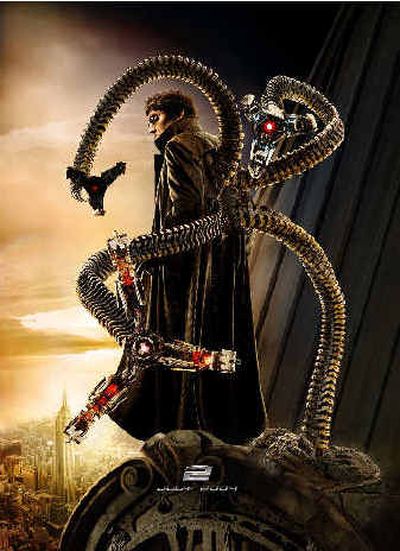Intriguing villain

What do you do when director Sam Raimi calls and asks you to be Doctor Octopus, one of the greatest villains in comic book history?
You say yes. Even if you’re not sure who the guy is.
Such was the predicament of Alfred Molina, the classically trained and Tony-nominated actor who plays the sinister Otto Octavius — aka “Doc Ock” — in “Spider-Man 2.”
Although Molina was a longtime fan of the comic books, he says, “for the life of me, I couldn’t remember Doc Ock. I remembered the Sandman and the Green Goblin and Lizard but not Doc Ock.
“But only an idiot would tell Sam, ‘Doc who?’ You say, ‘Sure, I love that guy.’ And then go back and read all the comic books you can find.”
What Molina did know is that the original “Spider-Man” was one of the biggest films of all time. And while comic-book adaptations were never high on his career goals list, working with Raimi was.
“There are some directors who believe in their material so much that you know it will be a worthwhile experience,” Molina says.
“And that was the case with Sam. So I took it.”
In doing so, he also took on the burden of improving the one weak link in the 2002 original.
For all of its critical praise and box-office records, “Spider-Man” did not deliver a satisfying villain in Green Goblin. Willem Dafoe’s performance as the tormented Norman Osborn passed muster with most comic book fans, but the Goblin’s chunky, bulbous outfit wouldn’t have taken a consolation prize at a Halloween party.
Goblin was hardly the first villain from comic book films to leave fans wanting. The “Batman” franchise turned out some of the lamest baddies in the pantheon of superhero stories, including Arnold Schwarzenegger’s Mr. Freeze and Tommy Lee Jones’ Two Face.
Gene Hackman’s goofy portrayal of Lex Luthor still pains some “Superman” fans.
But those films did not take in $820 million worldwide, as “Spider-Man” did in 2002, or have sequels lined up through 2007, as this franchise does.
So the first order of business for Raimi and the honchos at Columbia and Marvel Studios was to beef up the baddies. Crews began working on Doc Ock’s monstrous, tentacled suit months before the script for the sequel was finished.
By the time Raimi put the call in to Molina, the good doctor’s outfit was finished. All the filmmakers had to decide was who to put in it.
And as much as Molina wanted to work with Raimi, he wasn’t sure how to play a criminal inside a 75-pound suit operated by a half-dozen puppeteers.
“I was scared,” says Molina, who tends to favor more character-driven films such as “Frida” and “Luther.”
“How do you make that work in that kind of costume? But I knew I wanted to try it. When you do it right, the villains can be as interesting as the heroes.”
For “Spider-Man 2,” Raimi and Marvel Studios chief Avi Arad wanted to create a nemesis to Peter Parker who would be difficult for fans to hate.
Arad’s suggestion was simple: Make them friends.
In the sequel, Parker, a college student, and Octavius, a brilliant scientist, meet during Octavius’ experiments with energy fusion. A freak accident leaves Octavius melded to four independent-thinking tentacles that morph his body and twist his mind into a life of crime.
And there’s only one superhero who can stop him.
“Now we have a kid who not only has to stop this monster, but likes the man inside,” says Arad. “Peter knows that he and Octavius are a lot alike.”
The twist is a reliable convention in villain-making, says Christopher Sharrett, a professor of communication at Seton Hall University in South Orange, N.J.
“The best movie villains are a reflection of the hero,” he says. “The Joker is like Batman’s id gone wild. Professor Moriarty is a double to Sherlock Holmes.
“Bad guys who represent a simple struggle of good versus evil are rather humdrum.”
Doc Ock, says star Tobey Maguire, is anything but.
“He’s very layered,” Maguire says. “He can do these horrible things to people, and then give a clever punch line. How do you not like a bad guy like that?”
Still, you don’t want audiences to like your villain too much or they begin to root for the wrong guy. Raimi opted to stray from one “Spider-Man” comic book plotline, in which Doc Ock marries Parker’s Aunt May, to keep the film focused on Ock’s menacing, growing hubris.
“We had to create some of Doc Ock’s character from scratch,” says Raimi, a reader of the comic books since he was 7. “We wanted him to represent a different ideal so there’d be a conflict for Peter in an idealistic way.
“Doc Ock is consumed with personal fulfillment, while Peter is trying to take the road toward responsibility. (Ock) is not so much an over-the-top bad guy, but someone who just has a different set of values.”
Those conflicting values play a part in the film’s somewhat unconventional climax, when Doc Ock and Spider-Man debate nearly as much as they fight.
“That’s my favorite scene,” Molina says of the showdown. “How many times do you see a movie where enemies are trying to talk about their situation?”
Still, Raimi does not want fans to think that Doc Ock has become a windbag. With tentacles that allow him to climb buildings and toss cars like walnuts, Doc Ock provides plenty of menace.
Plus, Raimi says, “He’s just cool.”
“I wanted to look at all of the comic book villains and find the one that kids really like,” the director says. “Doc Ock fits the bill. He’s a great visual.
“He’s got those arms that can test Spidey’s ability. His tentacles make him a little slower against Spidey’s agility. But it’s a great match-up. It’s cool.”